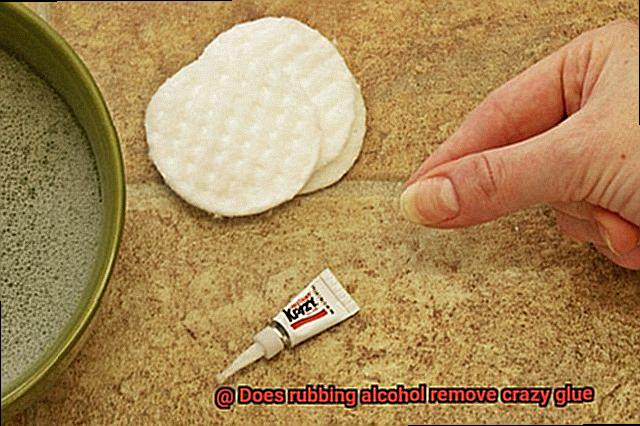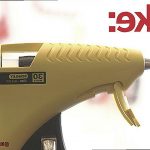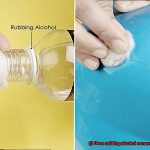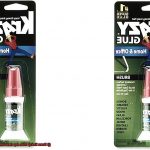Picture this: you’re innocently tinkering away, and then it happens – a dreaded mishap. Suddenly, your beloved possession is adorned with a stubborn smudge of super glue (or as we affectionately call it, crazy glue). Panic sets in as you envision a lifetime of sticky reminders. Fear not, my friend. For years, desperate souls have sought the holy grail of solutions to free themselves from this adhesive nightmare. And one name keeps popping up in these conversations – rubbing alcohol. But does it possess the power to save the day?
In this captivating blog post, we embark on an epic quest to uncover the truth behind using rubbing alcohol to obliterate crazy glue. We’ll explore its effectiveness on various surfaces – be it glass, plastic, or even your own skin. Brace yourself for an enlightening discussion on the merits and drawbacks of this DIY remedy. So gather ’round, fellow glue victims. Together, we shall unveil whether rubbing alcohol is the enchanted elixir we’ve been yearning for all along.
What is Rubbing Alcohol?
Contents
- 1 What is Rubbing Alcohol?
- 2 What is Crazy Glue?
- 3 Can Rubbing Alcohol Remove Crazy Glue?
- 4 Testing the Surface for Damage
- 5 Applying Rubbing Alcohol to the Glued Area
- 6 Gently Scraping off the Softened Glue
- 7 Repeating the Process if Necessary
- 8 Using Higher Concentrations of Rubbing Alcohol
- 9 Alternatives to Removing Crazy Glue with Rubbing Alcohol
- 10 Conclusion
Rubbing alcohol, also known as isopropyl alcohol, is a versatile household product with a wide range of uses. From disinfecting wounds to removing stubborn stains and even crazy glue, this colorless liquid has become a staple in many homes. In this blog post, we will explore the properties and uses of rubbing alcohol, with a specific focus on its effectiveness in removing crazy glue from surfaces.
Properties and Disinfecting Uses:
Rubbing alcohol is composed of approximately 70% isopropyl alcohol and 30% water, giving it strong disinfecting properties. Its high alcohol content enables it to kill bacteria, viruses, and fungi on surfaces. When used to clean wounds or sterilize medical equipment, rubbing alcohol helps prevent infections. It can also be used to clean household items such as countertops, electronics, and bathroom fixtures, providing an extra layer of protection against harmful germs.
Solvent Properties and Stain Removal:
In addition to its disinfecting capabilities, rubbing alcohol is an effective solvent. Its ability to dissolve substances makes it useful for removing stubborn stains and adhesive residue. Rubbing alcohol can be used to clean eyeglasses, remove ink or marker stains from clothing, and dissolve sticky substances like chewing gum or glue. Its versatility as a stain remover makes it a handy tool for tackling various cleaning tasks around the house.
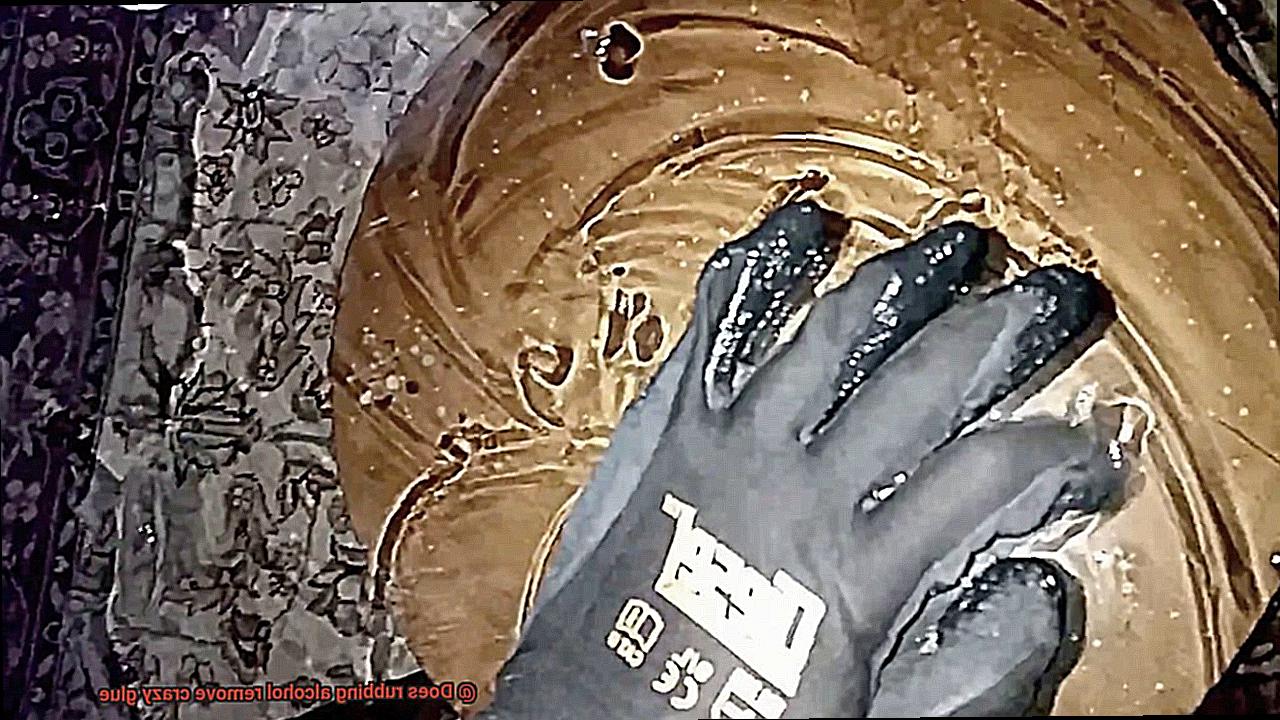
Crazy Glue Removal:
When it comes to removing crazy glue, rubbing alcohol can be a valuable ally. By weakening the bond between the glue and the surface it is stuck to, rubbing alcohol makes it easier to remove. To use rubbing alcohol for this purpose, simply soak a cotton ball or cloth in the alcohol and gently rub it onto the glued area. After allowing the alcohol to work its magic for a few minutes, try peeling or scraping away the glue using a plastic scraper or your fingernail. The alcohol effectively loosens the glue, allowing you to easily free the surface from its sticky grip.
Safety Precautions:
While rubbing alcohol is generally safe to use, it is important to take some precautions. Never ingest rubbing alcohol and avoid applying it to open wounds without proper medical guidance. Additionally, always test a small and inconspicuous area of the surface before using rubbing alcohol to remove crazy glue, as it may cause damage or discoloration in some materials.
What is Crazy Glue?
Crazy Glue, also known as cyanoacrylate adhesive, is an extraordinary adhesive that has revolutionized the world of bonding materials together. Discovered by accident in the 1940s by Dr. Harry Coover, this powerful glue was initially intended for creating a clear plastic material for war-related purposes. Little did he know that he had stumbled upon a game-changing invention that would become a household staple.
What makes Crazy Glue so special? Well, for starters, it’s all about speed and strength. This super glue forms an instant bond upon contact with moisture, allowing surfaces to stick together in a matter of seconds. No more waiting around for hours for your project to dry – Crazy Glue gets the job done in no time.
But that’s not all. Crazy Glue is incredibly versatile when it comes to bonding various materials. It can handle metal, plastic, rubber, wood, and so much more. This makes it the go-to adhesive for all your household repairs and craft projects, making your life easier and more efficient.
And let’s not forget about its impressive strength. Once Crazy Glue has bonded two surfaces together, it creates an unbreakable connection that can withstand impact and vibration. Say goodbye to flimsy repairs and hello to long-lasting durability.
Now, when it comes to choosing the right form of Crazy Glue, you have options. It is available in both liquid and gel formulas. The liquid form is ideal for smooth surfaces, while the gel form offers better control and is suitable for vertical or porous surfaces. Whichever variant you choose, rest assured that both deliver the same incredible bonding strength.
Of course, like any powerful tool, safety is key. Crazy Glue can bond skin together if not handled carefully, so be sure to wear gloves when using it or avoid direct contact with your precious skin. And if you do accidentally bond your fingers together (we’ve all been there), don’t panic. Simply soak the affected area in warm soapy water to gently separate the bonded skin.
Can Rubbing Alcohol Remove Crazy Glue?
Maybe you accidentally got some on your favorite countertop or glued your fingers together while attempting a DIY project. Don’t panic. There might be a solution right in your medicine cabinet – rubbing alcohol.
Rubbing alcohol, also known as isopropyl alcohol, is a common household solvent that can be used for a variety of cleaning and disinfecting purposes. It can also be surprisingly effective in removing crazy glue from certain surfaces.
Before we dive into the details, let’s talk about why rubbing alcohol can work its magic on crazy glue. Crazy glue, or cyanoacrylate adhesive, forms a strong bond by polymerizing in the presence of moisture. Rubbing alcohol acts as a solvent, breaking down the adhesive properties of the glue and making it easier to remove.
When it comes to non-porous surfaces like glass or metal, rubbing alcohol is a superhero in disguise. Simply apply a small amount of rubbing alcohol to a cotton ball or cloth and gently rub the affected area until the crazy glue starts to dissolve. Then, wipe away any residue with a clean cloth. Voila. Your surface will be free from the clutches of crazy glue.
However, not all surfaces are created equal. Porous materials like fabric or wood can pose more of a challenge when it comes to removing crazy glue. The adhesive properties of crazy glue can penetrate into these materials, making it difficult for rubbing alcohol to fully dissolve the glue. In such cases, you may need to consider alternative methods, such as using acetone or nail polish remover.
When using rubbing alcohol to remove crazy glue, it’s important to exercise caution. Rubbing alcohol is flammable, so keep it away from open flames or heat sources. Additionally, always test the alcohol on a small, inconspicuous area of the surface before applying it to the entire affected area. This will help you avoid any potential damage or discoloration.
If rubbing alcohol doesn’t do the trick, don’t despair. There are other options available. Acetone or nail polish remover, which contain stronger solvents than rubbing alcohol, can be used on non-porous surfaces. Alternatively, you can explore commercial adhesive removers specifically designed to tackle stubborn glue residues.
Testing the Surface for Damage
We’ve all experienced the frustration of dealing with crazy glue mishaps, but before we jump into removing that stubborn adhesive, it’s crucial to test the surface for potential damage. In this superhero guide, we’ll explore the best way to ensure your beloved surface remains unharmed during the removal process.
Selecting the Perfect Testing Spot:
To begin, find a small and inconspicuous area on the surface where you can perform the test. This could be a corner or an underside of the material, depending on accessibility. By choosing an inconspicuous spot, you can evaluate any potential damage without risking the appearance of your cherished surface.
Rubbing Alcohol – The Trusty Sidekick:
Grab your trusty sidekick – rubbing alcohol. Pour a small amount onto a clean cloth or cotton ball and gently rub the affected area. Ensure the alcohol comes in contact with the crazy glue. Watch closely for any adverse reactions.
Observe and Assess:
Keep a keen eye on how the surface responds to the rubbing alcohol. Look out for discoloration, fading, or deterioration of the material. If everything looks good and there are no visible signs of damage, it’s likely safe to proceed with your chosen removal method.
When Damage Strikes:
If you notice any negative reactions during the test, such as color change or texture alteration, it’s time to reconsider using rubbing alcohol as a removal agent. Don’t worry. There are alternative methods that are less likely to cause harm – acetone or commercial adhesive removers can come to your rescue.
Manufacturer Instructions – The Hero’s Handbook:
Before embarking on your mission to remove crazy glue, consult any manufacturer instructions or guidelines provided for both the surface and the glue itself. These valuable resources may offer specific insights into suitable removal methods or precautions necessary to protect the surface.
Applying Rubbing Alcohol to the Glued Area
Rubbing alcohol, our trusty sidekick, possesses amazing powers to dissolve adhesives and rescue your beloved surfaces. In this engaging blog post, we will guide you through the steps of applying rubbing alcohol to a glued area, ensuring a successful and damage-free rescue mission.
Step 1: Prepare the Battlefield
Before embarking on your glue removal adventure, ensure that the glued area is pristine. Cleanse it of any debris or dirt that might hinder our superhero’s intervention. Scrub it gently with soap and water or use a mild detergent to create a surface ready for the unmasking of the adhesive.
Step 2: Unleash the Power of Rubbing Alcohol
Now it’s time to bring out our secret weapon – rubbing alcohol. Pour a small amount onto a clean cloth or cotton ball. With a touch as gentle as a butterfly’s kiss, dab it onto the glued area. Vigorous rubbing is not needed; let the magic unfold with patience and grace.
Step 3: The Waiting Game
Allow the rubbing alcohol to work its enchantment. Let it sit on the glued area for a few minutes, giving it enough time to penetrate the adhesive and weaken its hold. As you wait, anticipation grows, knowing that liberation is just moments away.
Step 4: Gentle Unmasking

Once the glue has relinquished its grip, it’s time for a delicate unmasking. With finesse and precision, peel or scrape off the softened adhesive. Use a plastic scraper or your fingernail, ever mindful not to mar or deface the surface underneath.
Step 5: Relentless Persistence
Some glues may put up a tenacious fight. If stubborn residue remains, repeat the process of applying rubbing alcohol and gently scraping until all traces of glue have vanished. Your unwavering resolve will triumph over even the most obstinate adhesives.
Step 6: The Test of Compatibility
Before embarking on your superhero mission, test rubbing alcohol on a small, inconspicuous area. This precautionary measure ensures that no damage or discoloration will befall your precious surface. Safety first, always.
Step 7: A Clean Finale
After successfully removing the glue, cleanse the area once again with soap and water. Eradicate any remnants or lingering odors from the alcohol. Revel in the satisfaction of a spotless and pristine finish.
Step 8: Prevention is Key
Proactive measures can save you from glue mishaps in the future. Don your gloves, lay down a protective surface, and apply glue sparingly. These precautions will shield you from any unwanted encounters with adhesive villains.
Gently Scraping off the Softened Glue
Don’t let stubborn glue get the best of you. With the right techniques and a little help from rubbing alcohol, you can easily and gently scrape off softened glue, saving your surfaces from their sticky predicament. In this comprehensive guide, we will explore the proper steps to ensure a successful rescue mission, allowing you to bid farewell to adhesive woes once and for all.
Step 1: Assessing the Softened Glue
Before diving into the scraping process, it’s crucial to determine if the glue has been sufficiently softened by rubbing alcohol. Gently press on the glue with a cloth or sponge soaked in rubbing alcohol. If it feels soft and pliable, you’re ready to proceed.
Step 2: Choosing Your Weapon
Every hero needs the perfect tool for the job, and in this case, your scraping tool is your trusty sidekick. For delicate surfaces like plastic or glass, opt for a plastic scraper or even a handy credit card. If you’re dealing with tougher surfaces such as metal or wood, a metal scraper or putty knife will come to the rescue.
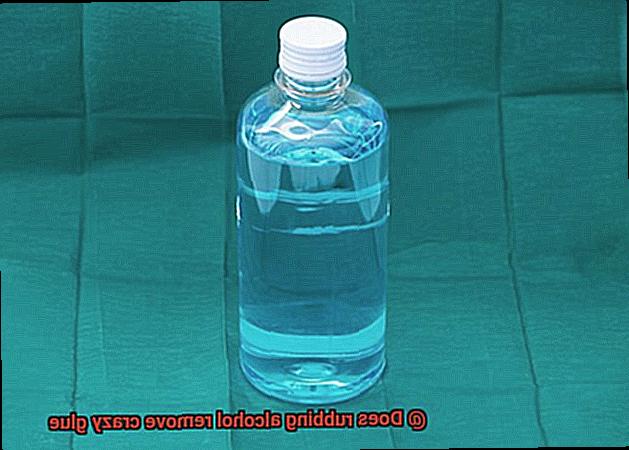
Step 3: Starting at the Edge
Armed with your chosen scraping tool, begin by applying gentle pressure at the edge of the softened glue. The key here is to maintain control and avoid any accidental scratches or damage. Slowly work your way towards the center of the glue, adjusting pressure as needed but always mindful not to exert too much force.
Step 4: Wiping Away Residue
As you scrape off the glue, periodically wipe away any residue with a cloth or sponge soaked in rubbing alcohol. This keeps the surface clean and prevents any lingering adhesive from causing further trouble.
Step 5: Surface-Specific Techniques
Different surfaces may require varying degrees of pressure and technique when scraping off softened glue. Delicate surfaces demand a lighter touch and more frequent wiping, while sturdier ones can handle slightly more forceful scraping. Adjust your approach accordingly to ensure a successful rescue mission.
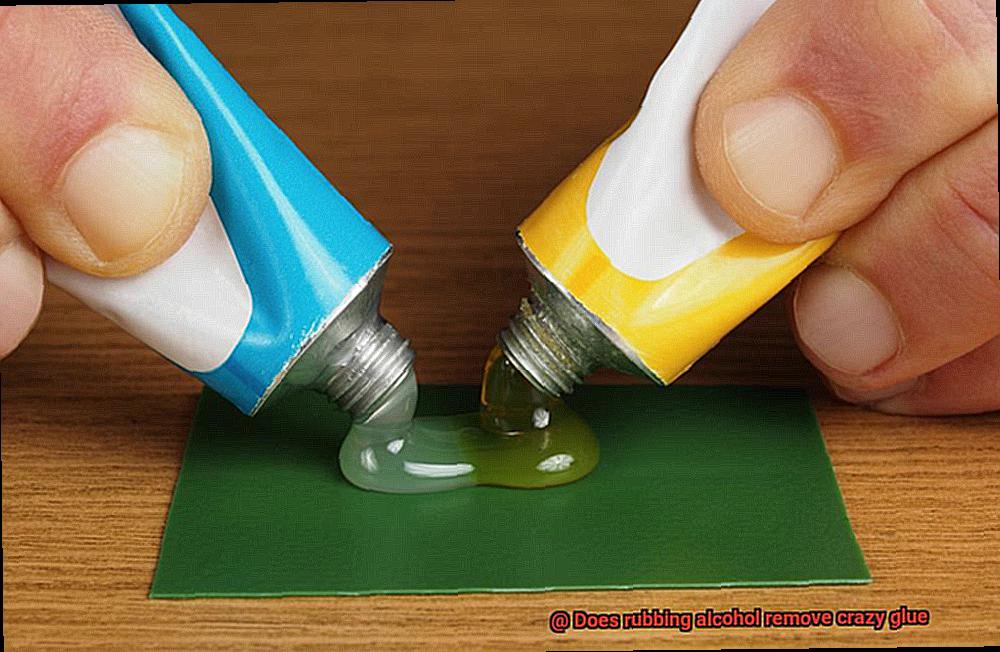
Step 6: Patience is Key
Remember, Rome wasn’t built in a day, and neither is the removal of stubborn glue. Be patient throughout the process, taking your time to gently scrape off the softened glue. Rushing or employing excessive force may result in unintended damage, which we definitely want to avoid.
Step 7: Post-Rescue Cleanup
Once you’ve successfully scraped off the softened glue and wiped away any residue, it’s time for some post-rescue cleanup. Clean the surface with mild soap and water or an appropriate cleaning solution. This final step removes any remaining alcohol or glue residue, leaving your surface clean and ready for its next adventure.
Repeating the Process if Necessary
When it comes to removing crazy glue with rubbing alcohol, sometimes one application just isn’t enough. Crazy glue can be stubborn, especially if it’s thick or generously applied. That’s where the trusty rubbing alcohol comes in, breaking down the adhesive properties of the glue. But occasionally, it needs a little extra time and effort.
So, how do you repeat the process if needed? Here’s a step-by-step guide:
- Get a clean cloth or cotton pad and apply a small amount of rubbing alcohol.
- Gently dab or rub the affected area, focusing on the glue residue. Allow a few minutes for the rubbing alcohol to work its magic.
- Take another clean cloth or cotton pad to wipe away the dissolved glue.
- If there’s still stubborn residue left, don’t worry. Repeat steps 1 to 3, applying more rubbing alcohol and giving it a few minutes before wiping again.
- Remember, patience is key during this process. We don’t want any damage to the underlying surface. Always test a small area before going all-in with the rubbing alcohol.
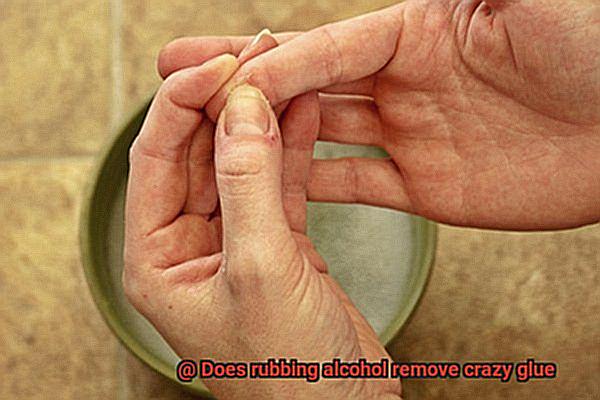
But what if repeated attempts with rubbing alcohol don’t give you satisfactory results? It’s time to consider other options. You could try acetone-based nail polish remover or specialized adhesive removers designed for strong adhesives like crazy glue.
Using Higher Concentrations of Rubbing Alcohol
Rubbing alcohol is a versatile solvent that can be used for various purposes, including cleaning, disinfecting, and even removing adhesives like crazy glue. Higher concentrations of rubbing alcohol, such as 90% or 99%, offer several benefits over lower concentrations. In this guide, we will explore the advantages of using higher concentrations of rubbing alcohol and provide safety tips for its proper use.
Advantages of Higher Concentrations:
- Increased effectiveness: Higher concentrations of rubbing alcohol have stronger solvent properties, making them more effective at dissolving adhesives, dirt, and grime. This makes them ideal for tougher cleaning tasks or when dealing with stubborn adhesives like crazy glue.
- Faster drying time: Higher concentrations of rubbing alcohol evaporate more quickly than lower concentrations. This means that surfaces cleaned with higher concentrations will dry faster, reducing the risk of moisture-related damage or streaks.
- Less residue: Higher concentrations of rubbing alcohol leave behind less residue compared to lower concentrations. This is particularly important when using rubbing alcohol for cleaning purposes, as it helps ensure a streak-free finish.
Safety Tips for Using Higher Concentrations:
- Proper ventilation: When using higher concentrations of rubbing alcohol, ensure that the area is well-ventilated to prevent the buildup of fumes. Open windows or use fans to promote airflow.
- Use protective equipment: Wear gloves and safety glasses when handling higher concentrations of rubbing alcohol to protect your skin and eyes from potential irritation.
- Avoid open flames: Higher concentrations of rubbing alcohol are highly flammable. Keep them away from open flames or heat sources to prevent accidents.
- Test on a small area: Before using higher concentrations of rubbing alcohol on a surface, test it on a small, inconspicuous area to ensure compatibility and prevent damage or discoloration.
- Store properly: Store higher concentrations of rubbing alcohol in a cool, dry place, away from direct sunlight or heat sources. Keep them out of reach of children and pets.
- Follow product instructions: Read and follow the instructions provided by the manufacturer for proper usage and dilution guidelines.
Alternatives to Removing Crazy Glue with Rubbing Alcohol
We’ve all experienced the frustration of accidentally gluing our fingers together or creating a sticky mess with crazy glue. While rubbing alcohol is often the first choice for removing this stubborn adhesive, there are times when it may not be readily available. But don’t panic. In this article, we’ll explore a variety of alternative methods that can effectively remove crazy glue without relying on rubbing alcohol.
Acetone:
One powerful solvent that can dissolve crazy glue is acetone, which can be found in nail polish removers. Apply a small amount of acetone to the affected area using a cotton ball or cloth. However, exercise caution as acetone is flammable and can irritate the skin. It’s essential to use it in a well-ventilated area.
Warm Soapy Water:
For smaller areas or objects that can be immersed in water, warm soapy water comes to the rescue. Immerse the glued area in warm soapy water for a few minutes and then gently scrub with a soft brush or sponge. The soap weakens the adhesive bonds, making removal easier and less messy.
Vinegar:
Harnessing the power of acidity, vinegar can effectively break down crazy glue bonds. Soak a cloth or sponge in vinegar and apply it to the affected area for several minutes. Gently rub off the glue using the cloth or sponge soaked in vinegar. You’ll be amazed at how well this natural alternative works.
Lemon Juice:
Another natural alternative with adhesive-breaking properties is lemon juice. Squeeze fresh lemon juice directly onto the glued area and allow it to sit for a few minutes before wiping away with a clean cloth. The citric acid in lemon juice helps to dissolve and loosen the adhesive properties of the glue.
Mechanical Methods:
If all else fails, you can resort to mechanical methods for removing crazy glue. Safely scrape off the glue with a plastic scraper or credit card, taking care not to damage or scratch the surface. This method requires patience and finesse, but it can be effective when other alternatives aren’t available.
_59ZzuLJcTw” >
Also Read: Can isopropyl alcohol remove super glue from glasses?
Conclusion
In conclusion, rubbing alcohol is indeed an effective solution for removing crazy glue.
Its powerful chemical properties break down the adhesive bond, allowing you to easily separate glued surfaces. So, if you find yourself stuck with crazy glue, fear not.
Just grab some rubbing alcohol and watch that stubborn glue vanish before your eyes. It’s like magic in a bottle.
Say goodbye to sticky situations and hello to a clean and pristine finish.

